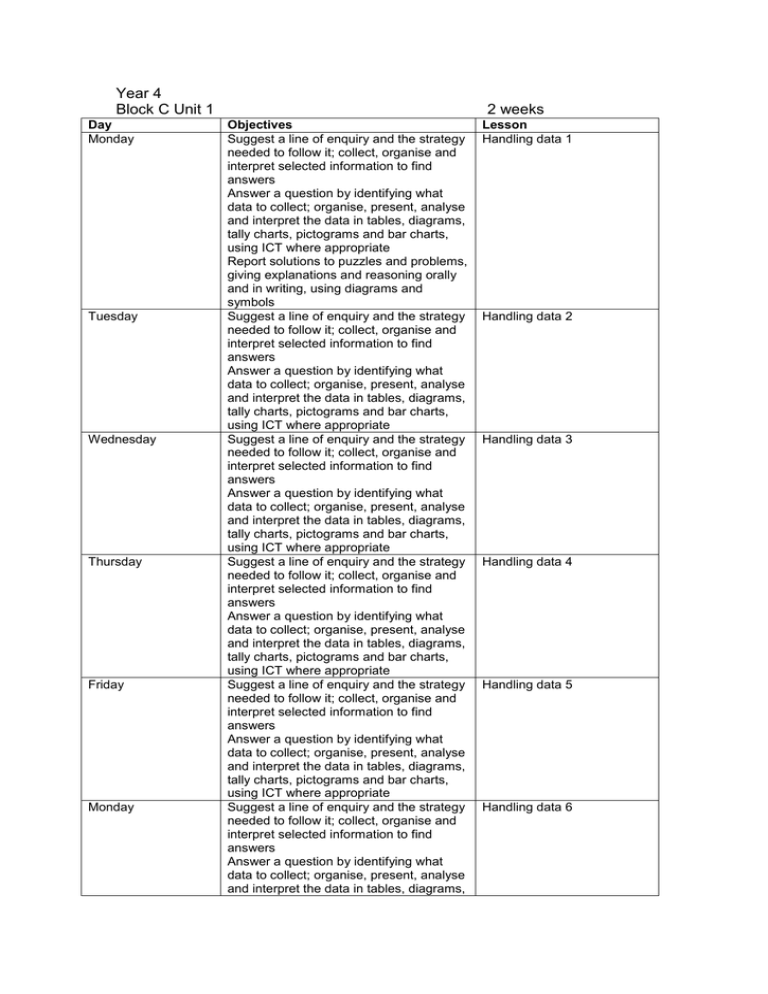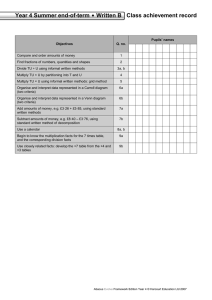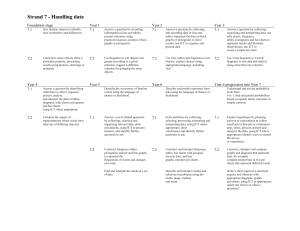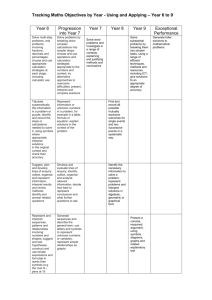Mathsworks Yearly Plans Year 4 Block C (DOC, 52 KB)
advertisement

Year 4 Block C Unit 1 Day Monday Tuesday Wednesday Thursday Friday Monday 2 weeks Objectives Suggest a line of enquiry and the strategy needed to follow it; collect, organise and interpret selected information to find answers Answer a question by identifying what data to collect; organise, present, analyse and interpret the data in tables, diagrams, tally charts, pictograms and bar charts, using ICT where appropriate Report solutions to puzzles and problems, giving explanations and reasoning orally and in writing, using diagrams and symbols Suggest a line of enquiry and the strategy needed to follow it; collect, organise and interpret selected information to find answers Answer a question by identifying what data to collect; organise, present, analyse and interpret the data in tables, diagrams, tally charts, pictograms and bar charts, using ICT where appropriate Suggest a line of enquiry and the strategy needed to follow it; collect, organise and interpret selected information to find answers Answer a question by identifying what data to collect; organise, present, analyse and interpret the data in tables, diagrams, tally charts, pictograms and bar charts, using ICT where appropriate Suggest a line of enquiry and the strategy needed to follow it; collect, organise and interpret selected information to find answers Answer a question by identifying what data to collect; organise, present, analyse and interpret the data in tables, diagrams, tally charts, pictograms and bar charts, using ICT where appropriate Suggest a line of enquiry and the strategy needed to follow it; collect, organise and interpret selected information to find answers Answer a question by identifying what data to collect; organise, present, analyse and interpret the data in tables, diagrams, tally charts, pictograms and bar charts, using ICT where appropriate Suggest a line of enquiry and the strategy needed to follow it; collect, organise and interpret selected information to find answers Answer a question by identifying what data to collect; organise, present, analyse and interpret the data in tables, diagrams, Lesson Handling data 1 Handling data 2 Handling data 3 Handling data 4 Handling data 5 Handling data 6 Tuesday Wednesday Thursday Friday Block C Unit 2 Day Monday Tuesday tally charts, pictograms and bar charts, using ICT where appropriate Choose and use standard metric units and their abbreviations when estimating, measuring and recording length, weight and capacity; know the meaning of 'kilo', 'centi' and 'milli' and, where appropriate, use decimal notation to record measurements (e.g. 1.3 m or 0.6 kg) Interpret intervals and divisions on partially numbered scales and record readings accurately,where appropriate to the nearest tenth of a unit Choose and use standard metric units and their abbreviations when estimating, measuring and recording length, weight and capacity; know the meaning of 'kilo', 'centi' and 'milli' and, where appropriate, use decimal notation to record measurements (e.g. 1.3 m or 0.6 kg) Interpret intervals and divisions on partially numbered scales and record readings accurately,where appropriate to the nearest tenth of a unit Report solutions to puzzles and problems, giving explanations and reasoning orally and in writing, using diagrams and symbols Assessment Units of measure 1 Units of measure 7 Using and applying 2 (N&C) 2 weeks Objectives Suggest a line of enquiry and the strategy needed to follow it; collect, organise and interpret selected information to find answers Compare the impact of representations where scales have intervals of differing step size Answer a question by identifying what data to collect; organise, present, analyse and interpret the data in tables, diagrams, tally charts, pictograms and bar charts, using ICT where appropriate Report solutions to puzzles and problems, giving explanations and reasoning orally and in writing, using diagrams and symbols Suggest a line of enquiry and the strategy needed to follow it; collect, organise and interpret selected information to find answers Compare the impact of representations where scales have intervals of differing step size Lesson Handling data 8 Handling data 9 Wednesday Thursday Friday Monday Tuesday Answer a question by identifying what data to collect; organise, present, analyse and interpret the data in tables, diagrams, tally charts, pictograms and bar charts, using ICT where appropriate Report solutions to puzzles and problems, giving explanations and reasoning orally and in writing, using diagrams and symbols Suggest a line of enquiry and the strategy needed to follow it; collect, organise and interpret selected information to find answers Compare the impact of representations where scales have intervals of differing step size Answer a question by identifying what data to collect; organise, present, analyse and interpret the data in tables, diagrams, tally charts, pictograms and bar charts, using ICT where appropriate Suggest a line of enquiry and the strategy needed to follow it; collect, organise and interpret selected information to find answers Compare the impact of representations where scales have intervals of differing step size Answer a question by identifying what data to collect; organise, present, analyse and interpret the data in tables, diagrams, tally charts, pictograms and bar charts, using ICT where appropriate Suggest a line of enquiry and the strategy needed to follow it; collect, organise and interpret selected information to find answers Compare the impact of representations where scales have intervals of differing step size Answer a question by identifying what data to collect; organise, present, analyse and interpret the data in tables, diagrams, tally charts, pictograms and bar charts, using ICT where appropriate Suggest a line of enquiry and the strategy needed to follow it; collect, organise and interpret selected information to find answers Compare the impact of representations where scales have intervals of differing step size Answer a question by identifying what data to collect; organise, present, analyse and interpret the data in tables, diagrams, tally charts, pictograms and bar charts, using ICT where appropriate Choose and use standard metric units and their abbreviations when estimating, measuring and recording length, weight Handling data 7 Handling data 10 Handling data 11 Handling data 12 Units of measure 2 Wednesday Thursday Friday and capacity; know the meaning of 'kilo', 'centi' and 'milli' and, where appropriate, use decimal notation to record measurements (e.g. 1.3 m or 0.6 kg) Interpret intervals and divisions on partially numbered scales and record readings accurately,where appropriate to the nearest tenth of a unit Choose and use standard metric units and their abbreviations when estimating, measuring and recording length, weight and capacity; know the meaning of 'kilo', 'centi' and 'milli' and, where appropriate, use decimal notation to record measurements (e.g. 1.3 m or 0.6 kg) Interpret intervals and divisions on partially numbered scales and record readings accurately,where appropriate to the nearest tenth of a unit Report solutions to puzzles and problems, giving explanations and reasoning orally and in writing, using diagrams and symbols Assessment Block C Unit 3 Day Monday Tuesday Wednesday Units of measure 8 Using and applying 5 (N&C) 2 weeks Objectives Suggest a line of enquiry and the strategy needed to follow it; collect, organise and interpret selected information to find answers Answer a question by identifying what data to collect; organise, present, analyse and interpret the data in tables, diagrams, tally charts, pictograms and bar charts, using ICT where appropriate Compare the impact of representations where scales have intervals of differing step size Suggest a line of enquiry and the strategy needed to follow it; collect, organise and interpret selected information to find answers Answer a question by identifying what data to collect; organise, present, analyse and interpret the data in tables, diagrams, tally charts, pictograms and bar charts, using ICT where appropriate Compare the impact of representations where scales have intervals of differing step size Suggest a line of enquiry and the strategy needed to follow it; collect, organise and interpret selected information to find answers Answer a question by identifying what data to collect; organise, present, analyse and interpret the data in tables, diagrams, Lesson Handling data 13 Handling data 14 Handling data 15 Thursday Friday Monday Tuesday Wednesday Thursday Friday tally charts, pictograms and bar charts, using ICT where appropriate Compare the impact of representations where scales have intervals of differing step size Choose and use standard metric units and their abbreviations when estimating, measuring and recording length, weight and capacity; know the meaning of 'kilo', 'centi' and 'milli' and, where appropriate, use decimal notation to record measurements (e.g. 1.3 m or 0.6 kg) Interpret intervals and divisions on partially numbered scales and record readings accurately,where appropriate to the nearest tenth of a unit Choose and use standard metric units and their abbreviations when estimating, measuring and recording length, weight and capacity; know the meaning of 'kilo', 'centi' and 'milli' and, where appropriate, use decimal notation to record measurements (e.g. 1.3 m or 0.6 kg) Interpret intervals and divisions on partially numbered scales and record readings accurately,where appropriate to the nearest tenth of a unit Choose and use standard metric units and their abbreviations when estimating, measuring and recording length, weight and capacity; know the meaning of 'kilo', 'centi' and 'milli' and, where appropriate, use decimal notation to record measurements (e.g. 1.3 m or 0.6 kg) Interpret intervals and divisions on partially numbered scales and record readings accurately,where appropriate to the nearest tenth of a unit Report solutions to puzzles and problems, giving explanations and reasoning orally and in writing, using diagrams and symbols Report solutions to puzzles and problems, giving explanations and reasoning orally and in writing, using diagrams and symbols Report solutions to puzzles and problems, giving explanations and reasoning orally and in writing, using diagrams and symbols Assessment Units of measure 3 Units of measure 6 Units of measure 9 Using and applying 8 (N&C) Using and applying 9 (N&C) Using and applying 14 (N&C)



